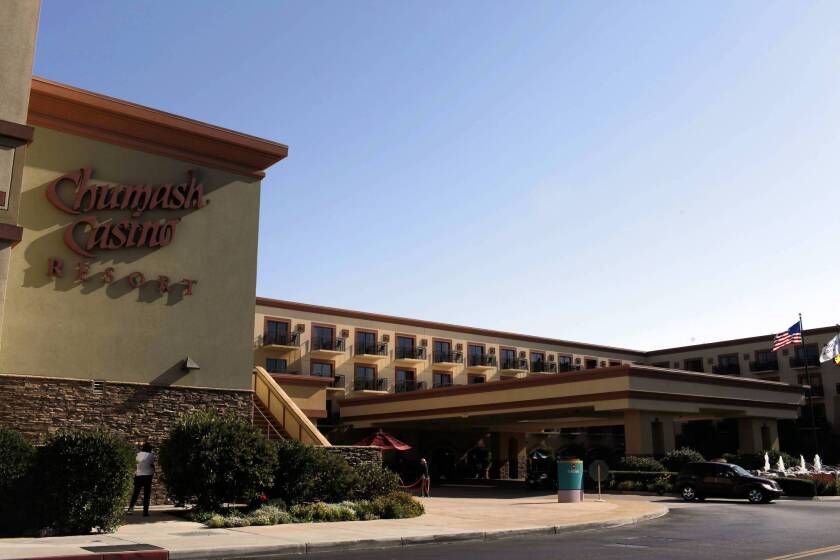Santa Ynez Indian Casino
The Chumash Casino Resort is owned and operated by the Santa Ynez Band of Chumash Mission Indians. Chumash is located near Santa Ynez Airport, in the Santa Ynez Indian Reservation, about 5 miles (8.0 km) east of Solvang, California. SANTA YNEZ VALLEY, Calif. The Chumash Casino Resort announced in a newsletter this week that 11 staff members have recently tested positive for COVID-19. The resort said this uptick in internal. Located off Highway 246 in Santa Ynez, Chumash Casino Resort offers gaming at its exhilarating best, featuring 2,000 Slot machines, dozens of Table Games, Bingo and Poker. Guests also have three dining choices from casual to formal. Hotel Corque provides complimentary shuttle service to and from Chumash Casino Resort every hour, 24-hours a day. The Santa Ynez Band of Chumash Indians opened Chumash Casino in 1994 in a small stucco building and added two temporary buildings in the following years. In 2002, the tribe decided to consolidate the buildings and transform the property into one impressive complex.

Bloodline: A woman fights the Santa Ynez Band of Chumash Indians to get tribal membership for her family
By DAVID MINSKY
Santa Ynez Indian Casino Restaurants
While the recent news cycle has been filled with stories of U.S. politicians and their constituents taking a stand against “illegal” immigrants, there’s a smaller, more internal struggle for citizenship happening in the heart of Santa Barbara County.
On March 8, a federal appeals court in California affirmed a decision denying Rosanna Miranda’s appeal to have her family included as members of the Santa Ynez Band of Chumash Indians. She applied to the tribe for their membership but was denied, and she has fought to prove her family’s ancestry ever since.
The case involves Miranda, her five daughters, and her sister, who she believes should be included as formal tribal members. Miranda applied to the Chumash’s enrollment committee in 1992, but didn’t receive an answer until 2002.
Members of Native American tribes are typically entitled to tribal benefits. With the Chumash, particularly, there’s identity, housing, and money at stake. Members receive proceeds from the casino, which opened in 1994.
With a steady stream of cash from the Chumash Casino Resort’s income, all 153 members of the Santa Ynez Chumash received “more than $1 million in casino proceeds” between 2000 and 2004, according to an October 2004 Los Angeles Times article.
Officials from the tribe didn’t return the Sun’s emails or phone calls before press time.
But Miranda said it’s not just about the money; it’s about having a say in tribal affairs.
Santa Ynez Indian Casino Entertainment
“Money does matter, but it’s having a voice in the tribe for the next generation,” Miranda told the Sun. “If they’re not part of the tribe, they won’t be able to vote on anything.”
Following her denial in 2002, Miranda appealed the decision to the Bureau of Indian Affairs (BIA), but the government agency didn’t respond. Meanwhile, she spent the next seven years trying to prove ancestry. She employed the services of a local anthropologist to help her case and even dug into the vast trove of genealogy records held by the Mormon church.
A person needs one-quarter Chumash blood in order to be a part of the tribe. Miranda’s already a member of the tribe with three-eighths ancestry, but believes it should be more, which would make her family members too.

In her lawsuit filed in 2014, Miranda bases her ancestry off her grandmother, Rosa Pace, who is listed as a full-blooded Chumash on a census that was taken in 1940.
It’s this census that Miranda said the Chumash officially adopted to prove membership in the tribe. With her grandmother listed as a full-blooded member, Miranda said this ought to make her daughters and sister (technically her half-sister) officially Chumash. But somehow things got mixed up.
A later census taken in 1965 listed Miranda’s grandmother as only one-half Chumash, which makes her family ineligible for membership. The tribe’s enrollment committee used the 1965 census for the denial in 2001, saying that Miranda couldn’t prove sufficient ancestry.
Miranda argued in her lawsuit that the enrollment committee should be using the 1940 census. After receiving no response from the BIA, Miranda eventually appealed again and the agency finally responded.
“Enrollment as a member of a federally recognized Indian tribe, band, community or group is a matter between the individual and the tribe,” the BIA wrote. “Tribes have complete authority and control over their own membership.”
This is the case with most tribes, said Miranda’s attorney Jonathan Velie, except there are some—like the Santa Ynez Chumash—that leave it up to the BIA to make a final decision regarding the enrollment appeals process. The BIA didn’t respond to inquiries placed by the Sun before press time.
Instead of referring to the 1940 census, Velie said the BIA deferred back to the enrollment committee’s decision to use the later census, which is why Miranda sued the agency.
“The 1940 census is worthless if you don’t use the blood quantum on it,” Velie told the Sun, adding that this sets a dangerous precedent for other tribes. “None of these people are strangers to the tribe.”
Velie said this case seems to follow a trend with other tribes denying membership. The Picayune Rancheria of Chukchansi Indians in Madera County has expelled hundreds of members, TheNew York Times reported in 2011, leaving them without the $300 per month stipend that comes from casino money.
“You have people who want to be tribal members, where no one knows who they are or where they came from,” Chukchansi tribal chairman Reggie Lewis told TheNew York Times. “We are sworn to uphold the Constitution. And basically that’s what we try to do.”
A similar situation occurred with the Pechanga Band of Luiseno Indians in Temecula, a case on which Velie also worked on during the early 2000s. In this case, the Pechanga ejected more than 100 of its members, who lost their tribal identities and a $10,000 per month stipend from casino revenues, the LA Times reported.


“The less people you have, the more money each person gets,” Velie said.
Monica Miller, the attorney on Miranda’s case for the BIA, argued that the agency was fair in evaluating the tribe’s decision and independently reviewing the evidence considering their laws.
“I don’t believe that the applicant—the plaintiff—showed to the bureau’s satisfaction that they had a quarter degree of Indian blood,” Miller said.
Miranda doesn’t place the blame with her tribe’s leadership, but on the members who make up the enrollment committee and with the BIA. The appeals court dismissed her case with prejudice, which means permanently. Miranda’s only recourse is to petition the U.S. Supreme Court, which she isn’t sure she’ll do.
“The government is still rotten and unfair,” Miranda said. “I’m not trying to knock down or bad mouth anyone, but what’s written is written.”
Staff Writer David Minsky can be reached at dminsky@santamariasun.com.